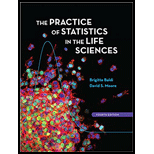
(a)
To make: a Venn diagram with information and consider options when labeling the diagram.
(a)
Answer to Problem 10.8AYK
The Venn diagram was constructed.
Explanation of Solution
Given:
An African study tested 543 children for the sickle-cell anemia trait and for malaria infection. Of those tested, 25% had sickle-cell, 34.6% had malaria and 6.6% had both sickle cell and malaria.
Calculation:
Based on this information a Venn diagram can be constructed. To do this, the probabilities of both malaria and not sickle-cell and sickle-cell and not malaria need to be calculated as follows:
To calculate the
From this, the probability that a child has neither sickle cell nor malaria can be calculated by taking 1 minus this above calculated value.
These values can now be used to complete the Venn diagram.

Conclusion:
Therefore, the Venn diagram was constructed.
(b)
To find: the probability that a given child has either malaria or the sickle-cell trait.
(b)
Answer to Problem 10.8AYK
The probability that a child has either malaria or sickle cell is 0.53.
Explanation of Solution
Calculation:
The probability that a given child has neither malaria nor sickle cell can be seen in the Venn diagram. In addition, to calculate the probability that a child has neither sickle cell nor malaria, first the probability a child has either sickle cell or malaria needs to be determined.
From this, the probability that a child has neither sickle cell nor malaria can be calculated by taking 1 minus this value.
The probability that a child has neither sickle cell nor malaria is 0.47.
Also, the probability that a child has either malaria or sickle cell can be determined using the given information. To do this, the probability that a child has sickle cell is added to the probability that a child has malaria. This value is then subtracted from the probability that a child has both.
Conclusion:
Therefore,the probability that a child has either malaria or sickle cell is 0.53.
(c)
To find: the probability that a given child has malaria, given that the child has the sickle-cell trait.
(c)
Answer to Problem 10.8AYK
The probability that a child has malaria given they do not have sickle cell is 0.373.
Explanation of Solution
Calculation:
The probability that a child has malaria given that a child has sickle cell is expressed as follows:
The probability that a child has malaria given they have sickle cell is 0.264.
The probability that a child has malaria given that they do not have sickle cell is expressed as follows:
First, the probability that a child does not have sickle cell needs to be determined by taking 1 minus the probability that a child has sickle cell (0.25).
Next, substitute the values into the formula given above.
Conclusion:
Therefore,the probability that a child has malaria given they do not have sickle cell is 0.373.
(d)
To describe: the
(d)
Answer to Problem 10.8AYK
Therefore, the probability of malaria and sickle cell using the multiplication rule gives a probability of 0.0865.As a result, these two events are not independent.
Explanation of Solution
Calculation:
To verify independence, the multiplication of the probabilities of malaria and sickle cell should be equal to the probability of malaria and sickle cell, which is 0.066.
Calculating the probability of malaria and sickle cell using the multiplication rule gives a probability of 0.0865. This is greater than and does not match the probability of both malaria and sickle cell of 0.066 as given in the example. As a result, these two events are not independent.
Conclusion:
Therefore, the probability of malaria and sickle cell using the multiplication rule gives a probability of 0.0865.As a result, these two events are not independent.
Want to see more full solutions like this?
Chapter 10 Solutions
Practice of Statistics in the Life Sciences
 MATLAB: An Introduction with ApplicationsStatisticsISBN:9781119256830Author:Amos GilatPublisher:John Wiley & Sons Inc
MATLAB: An Introduction with ApplicationsStatisticsISBN:9781119256830Author:Amos GilatPublisher:John Wiley & Sons Inc Probability and Statistics for Engineering and th...StatisticsISBN:9781305251809Author:Jay L. DevorePublisher:Cengage Learning
Probability and Statistics for Engineering and th...StatisticsISBN:9781305251809Author:Jay L. DevorePublisher:Cengage Learning Statistics for The Behavioral Sciences (MindTap C...StatisticsISBN:9781305504912Author:Frederick J Gravetter, Larry B. WallnauPublisher:Cengage Learning
Statistics for The Behavioral Sciences (MindTap C...StatisticsISBN:9781305504912Author:Frederick J Gravetter, Larry B. WallnauPublisher:Cengage Learning Elementary Statistics: Picturing the World (7th E...StatisticsISBN:9780134683416Author:Ron Larson, Betsy FarberPublisher:PEARSON
Elementary Statistics: Picturing the World (7th E...StatisticsISBN:9780134683416Author:Ron Larson, Betsy FarberPublisher:PEARSON The Basic Practice of StatisticsStatisticsISBN:9781319042578Author:David S. Moore, William I. Notz, Michael A. FlignerPublisher:W. H. Freeman
The Basic Practice of StatisticsStatisticsISBN:9781319042578Author:David S. Moore, William I. Notz, Michael A. FlignerPublisher:W. H. Freeman Introduction to the Practice of StatisticsStatisticsISBN:9781319013387Author:David S. Moore, George P. McCabe, Bruce A. CraigPublisher:W. H. Freeman
Introduction to the Practice of StatisticsStatisticsISBN:9781319013387Author:David S. Moore, George P. McCabe, Bruce A. CraigPublisher:W. H. Freeman





